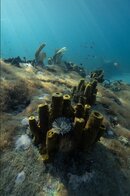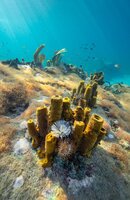I truly appreciate the time you took in replying. Thank you for clarifying some aspects. Although I have been reading a lot about this, there are specifics that are way over my understanding, it is indeed a very complex optics issue. If you read above comment to tusiops, you will see some of the articles you were probably talking about. I have been scratching my head ever since I got this dome under water. And I have to mention again, I don't use strobes and I am not interested in using strobes, so I pay a big price for small apertures.You're running into a fundamental physics issue. A dome port in water acts as a lens element, presenting the lens behind it with a curved virtual image. Google 'dome port theory' and you'll find a bunch of articles with detailed explanations, but the gist of it is, even if you're shooting a straight wall head-on, it becomes a dome with the curvature proportional to your dome port's radius, so the corners are significantly closer to your camera than the center.
Depth of field is inversely proportional to magnification, so large sensor cameras - and your is, I infer from the lens, full-frame - have a thinner depth of field at an equivalent aperture setting than a smaller sensor camera would.
Depth of field is also inversely proportional to the aperture, so closing down the aperture will bring more of the image into sharper focus. I shoot an APS-C camera (Sony a6300) and I typically use f/8 to f/11; with a full-frame camera, you should probably be targeting f/13-f/16 as a baseline, especially with a small dome.
Yes, this means raising the ISO and/or slowing down the shutter speed to compensate, as well as raising strobe power - this is the reason why large-sensor cameras need big powerful strobes for wide-angle shots, whereas small-sensor compacts can get away with smaller ones.
You can also get a larger dome to counteract this effect - while Ikelite doesn't sell any domes larger than 8 inches, you can get the much larger Zen DP230 in an Ikelite mount. You don't mention which specific dome you have, but from the photos in your post and Ikelite's offer to get the 'full dome', I infer that you're using the 75344 compact dome - Ikelite's recommended setup for better edge sharpess is indeed 75340 8-inch dome, and this can indeed help, although shooting rectilinear wide full-frame at f/4 is a pipe dream regardless of dome size.
Finally, you can switch to a fisheye lens; either Canon 8-15mm f/4L or a Sigma 15mm, using a Metabones or MC-11 adapter. This will give you a much wider field of view and greater depth of field, at the cost of barrel distortion. Most underwater photographers prefer fisheyes over rectilinear ultrawide lenses, unless shooting manmade objects with straight lines such as wrecks - see this thread for some examples why: The advantages of fisheye zooms!
Note that the Canon 8-15mm, by itself, has basically two settings - a circular fisheye (i.e. a round image covering a hemisphere surrounded by black) at 8mm, and a 180 degree diagonal fisheye at 15mm - intermediate positions just give you varying degrees of vignetting. If you don't want the circular fisheye look, you can mount it on a teleconverter to get some more reach. A 1.4x teleconverter will give you 180 degree fisheye at 11mm, whereas a 2x teleconverter will give you the full zoom range. However, if you opt of the 2x option, make sure to get the latest Kenko Teleplus HD Pro version, as older ones produce significant image quality degradation.
If you really want to shoot at wide apertures underwater, then your only real solution is a Nikonos RS 13mm adaptation by Isaac Szabo - see this article for full details: Review of the Nikonos 13mm Conversion for Sony Mirrorless It is currently only available in Nauticam and SeaFrogs mounts, but I'm sure Isaac could develop an Ikelite adapter if needed. It is, however, a very limited availability item, with two samples up on ebay as I'm writing this - one for $3400 and another for $3900, plus the $1000 conversion fee and the $200-ish Sony 50mm donor lens. It used to be cheaper, in the $1200-1500 range, but the availability of a viable conversion method for modern mirrorless cameras (there were older conversions, but they only worked for Nikon DSLRs) has spiked demand, and thus prices, since this lens was only produced from 1992 to 1996, there are maybe a few hundred in circulation, and no more will ever be made.
The truth is that in the absence of real testing in my hands, as a client, I can only rely on Ikelite's lens guide and descriptions before purchasing online. I couldn't have forseen this and nothing to me indicated that I was goint to be experiencing this level of distortion to the extent that I regret my choice.
Here is the link to other test images at different apertures if you feel so inclined:
I trusted they had made their optical tests for this lens and considering their article online went for it. There was no indication whatsoever about your above caveats.
Perhaps with years of experience such as yours, one has a better understanding of gear limitations.
Still, I feel shutting the door with the client will never be the way forward. All I want right now is to change this for a 8"dome.






